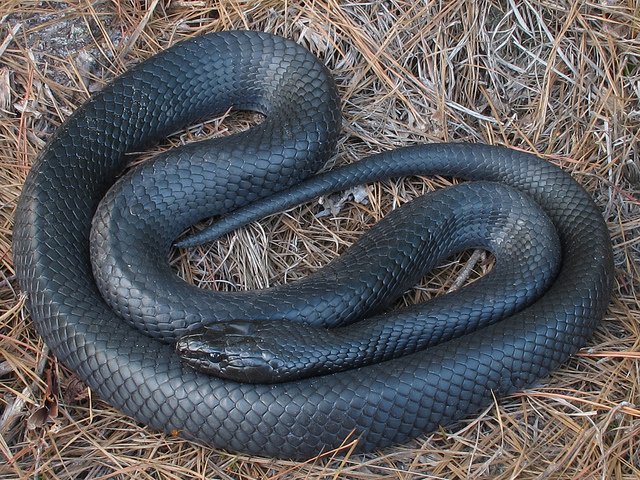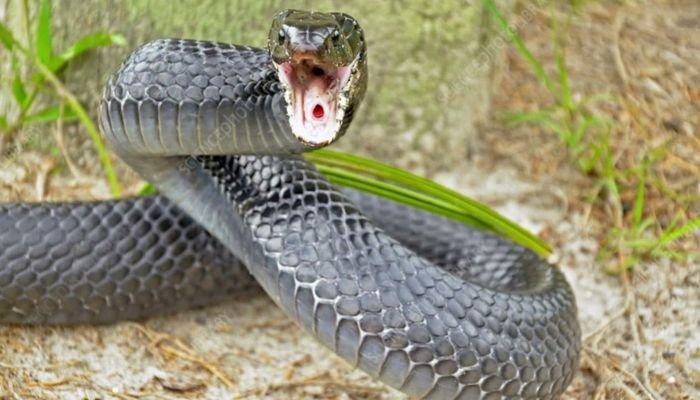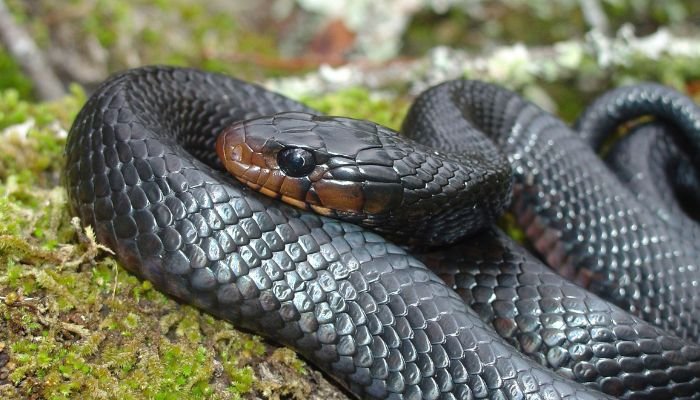
Eastern Indigo Snake, an officially protected species, resides in the southern region of the United States. It is the nation’s longest native serpent and is distinguished by its iridescent blue-black coloring. As apex predators, eastern indigo snakes consume a variety of animals, including small mammals, birds, and reptiles. In the management of rodent populations, they are crucial ecological actors.. Here are Eastern indigo snake Guide on Food, Habitat, Size, Lifespan & Predators below-
Eastern indigo snake Stats in Table format
The stats are given below for Eastern indigo snake
| Reptiles List | Eastern indigo snake |
|---|---|
| Family | Colubridae |
| Type | Snake |
| Size | Large |
| Length | Eastern indigo snake: Up to 6-9 feet (1.8-2.7 meters) |
| Color | Eastern indigo snake: Typically has a shiny blue-black coloration. |
| Weight | Eastern indigo snake: Can weigh between 4 to 10 pounds.. |
| Lifespan | 20-30 years (or more) |
| Reproduction | Oviparous, lays eggs |
| Gestation Periods | The gestation period for Eastern indigo snakes is unknown. |
| Endangered Status | Threatened (IUCN Red List) |
| Features | Shiny blue-black scales, non-aggressive |
| Country & Areas | United States, specifically found in the southeastern states of Alabama, Florida, Georgia, Mississippi, South Carolina, and Louisiana. |
Eastern Indigo Snake Natural Habitat and Distribution
The Eastern indigo snake, or Drymarchon couperi, is a harmless snake species in the colubrid genus. Alabama, Georgia, and Florida are the states in the southeastern United States where you can see this magnificent snake. Because of its eye-catching iridescent blue-black coloring, this species is also known as the blue indigo snake.
Eastern Indigo Snake Physical Features and Adaptations
Here are some information about Eastern Indigo Snake:-
Body Structure
Adult Eastern indigo snakes can grow to be as long as 9 feet (2.7 meters) on rare occasions, making it the longest snake native to the United States. Their slim and lengthy form makes them adept at traversing a wide range of environments. Despite their colossal size, they weigh little in relation to their length because of their streamlined build.
Coloration and Patterns
The stunning pattern of black crossbands against a reddish-brown background first appears on Eastern indigo snakes when they are just a few years old. When fully grown, however, their scales take on a glossy, dark blue-black color, with some individuals showing more pronounced reddish-brown or purple highlights. Because of the vividness of their coloring, these reptiles stand out from the crowd and are instantly recognizable.
Defense Mechanisms
Non-venomous, eastern indigo snakes use alternative forms of self-defense instead of venom. They may flatten their heads and vibrate their tails when frightened, making them look more menacing like venomous snakes. To further deter potential predators or threats, they may hiss loudly or release a putrid stench.
Eastern Indigo Snake Diet and Feeding Habits
Here are some information about Eastern Indigo Snake:-

Diet Type
Carnivorous by nature, eastern indigo snakes eat mostly other snakes and lizards. They are noted for being opportunistic predators that can eat a wide range of foods.
Preferred Food Sources
Mice, rats, and other small mammals, as well as birds, bird eggs, frogs, lizards, and even other snakes, are all fair game. They are able to thrive in a variety of environments because they can feed on a wide variety of animals.
Feeding Schedule
Constrictors like the eastern indigo snake use their superior size and strength to overcome and suffocate their prey. When they eat depends on their metabolism and how readily available food is. Depending on conditions including temperature, season, and individual size, they may feed anywhere from once every few days to once every few weeks.
Eastern Indigo Snake Housing and Enclosure Requirements
Here are some information about Eastern Indigo Snake:-
Terrarium Size and Setup
Eastern indigo snakes need large, naturalistic cages to thrive when kept as pets. For an adult snake, you should provide a terrarium that is at least 6 feet (1.8 meters) in length, 2 feet (0.6 meters) in width, and 2 feet (0.6 meters) in height. It’s crucial to give them plenty of places to hide, like behind big boulders or in man-made caverns.
Substrate Options
Pick a substrate that is able to keep some moisture without getting completely saturated. You can use cypress mulch, coconut coir, or a combination of the two as the floor of the enclosure.
Temperature and Lighting
The body temperature of an eastern indigo snake is controlled by external heat sources since it is ectothermic. Maintain a temperature gradient in the cage, with a warm place reaching 85–90 degrees Fahrenheit (29–32 degrees Celsius) and a cooler spot reaching 75–80 degrees Fahrenheit (24–27 degrees Celsius). To keep temperatures stable, use under-tank heating pads or ceramic heat emitters.
Humidity and Water Needs
Keep the relative humidity in the enclosure between 50 and 60 percent. The substrate can be misted on a regular basis, and the snake can soak in a large water dish. Eastern indigo snakes, like many other snakes, like bathing in water as a means of maintaining proper hydration.
Eastern Indigo Snake: Reptile Behavior and Temperament
Here are some information about Eastern Indigo Snake:-
Activity Levels:
Diurnal means that eastern indigo snakes are most active during the day. They spend a large deal of their day moving quickly and powerfully as they stalk prey in their natural environment. Because of their massive size and high metabolic rate, they are capable of traveling great distances in search of food. Some may seek refuge from the summer sun by moving indoors or to cooler, shadier locales. They may enter a state of dormancy known as brumation when the weather turns chilly.

Social Behaviour:
Solitary by nature, eastern indigo snakes only interact with others during mating and territorial disputes. Unlike several other reptile species, chameleons are not known for being social or for living in colonies. However, male indigo snakes may fight between themselves during the mating season. This is done for the purpose of establishing dominance and gaining access to females.
Handling and Taming:
Snakes of the eastern indigo are not kept as pets because they are a wild species. Only knowledgeable people, such as herpetologists or snake keepers, should handle them with care. Although certain indigo snakes may tolerate handling, doing so excessively or on a regular basis is not recommended because it can induce stress and, in extreme cases, lead to defensive responses or bites. In most cases, it’s advisable to avoid handling them as much as possible and let them stay in their enclosure.
Eastern Indigo Snake Breeding and Reproduction:
Here are some information about Eastern Indigo Snake:-
Mating and Courtship Rituals:
The mating season for eastern indigo snakes occurs in the late winter to early spring. Males fight for the attention of females, and the winner takes everything. A male will execute a sequence of wooing activities, such as rubbing against a female, intertwining their bodies, and flicking their tongues, once he has established his dominance over her. Mating will take place if the female finds the man acceptable.
Incubation and Hatchlings:
When the mating process is complete, the female will lay her eggs in a safe and secret place like a burrow or some rotting plants. There could be anywhere from 4 to 12 eggs in the nest. After she lays her eggs, the female does not take care of her young. Depending on the temperature and humidity, incubation might last anywhere from 60 days to 80 days. The moment they emerge from their eggs, the young are on their own and must learn to survive.
Eastern Indigo Snake Common Health Issues and Veterinary Care:
Here are some information about Eastern Indigo Snake:-
Respiratory Infections:
Eastern indigo snakes are susceptible to respiratory diseases if housed improperly or subjected to low temperatures and heavy humidity. Respiratory infections can cause a variety of symptoms, including wheezing, mouth breathing, and runny nose. Immediately seeking veterinarian care is essential if any of these symptoms are noticed.
Parasites:
Eastern indigo snakes, like many other reptiles, are susceptible to parasitic infections. Parasites, both those found internally (like worms) and externally (like mites), can be harmful if not eliminated. A reptile vet can advise you on the best preventative methods and how often to check for parasites in your pet’s feces.
Metabolic Bone Disease:
Reptiles often suffer from metabolic bone disease (MBD) due to insufficient calcium and other minerals in their diet. Bone weakness, deformities, and other complications can result from MBD. Preventing MBD in captive indigo snakes requires a diet rich in calcium and other vitamins and minerals.

Importance of Regular Vet Check-ups:
If you keep an Eastern indigo snake as a pet, you should take it in for regular medical checkups to ensure its health. A qualified reptile vet can examine your pet in great detail, offer guidance on how to care for your reptile, and identify any potential health problems at an early stage. If medical issues are caught early, patients have a much better chance of making a full recovery.
Conclusion:
The Eastern indigo snake is an amazing and fascinating reptile because of its one-of-a-kind habits, sexual behavior, and reproduction. They need to be treated as wild animals and given a confined environment that is as close as possible to their natural habitat. To keep them healthy and alive for as long as possible in captivity, it is essential that they receive regular veterinary care. We may better appreciate and safeguard these amazing snakes for future generations if we learn about and adhere to their natural habits and needs.
FAQs
Q: What is the family and Type of an Eastern indigo snake?
A: The Eastern indigo snake is a species of family Colubridae. The Famous Eastern indigo snake is a member of the family Snake.
Q: What is the average size of an Eastern indigo snake?
A: The average adult Eastern indigo snake is Large between Eastern indigo snake: Up to 6-9 feet (1.8-2.7 meters).
Q: How long can an Eastern indigo snake grow in size in lengths?
A: Eastern indigo snake is Large in size and The Eastern indigo snake can grow up to an impressive length of 6-9 feet or 1.8-2.7 meters.
Q: What colors do Eastern indigo snakes come in?
A: The Eastern indigo snake is known for its stunning shiny blue-black coloration..
Q: How big can an Eastern indigo snake get in weight?
A: The Eastern indigo snake is a fascinating reptile that typically weighs between 4 to 10 pounds.
Q: What are the special Features of an Eastern indigo snake?
A: Eastern indigo snake are Shiny blue-black scales, non-aggressive
Q: How long do Eastern indigo snake live?
A: The usual lifespan of an Eastern indigo snake is The Eastern indigo snake has a lifespan of 20-30 years or even longer.
Q: What food does the Eastern indigo snake eat?
Mainly rodents make up the Eastern indigo snake’s diet. There have been reports of birds, frogs, lizards, and even other snakes being discovered in its stomach. To kill its prey, this species of constrictor wraps its body around it and squeezes until the victim suffocates. The Eastern indigo snake is an important predator that eats a wide range of different animals.
Q: What is the best habitat for an Eastern indigo snake?
Eastern indigo snakes need a habitat that includes both open pine forests and hardwood hammocks, as well as wetlands. Southeastern states including Florida, Georgia, and Alabama are perfect habitats for these snakes. They like habitats rich in grass, bushes, and trees, which they can employ for concealment and foraging. The Eastern indigo snake requires both a terrestrial and aquatic habitat due to its skill as a swimmer and its frequent use of wetland areas for foraging and reproduction. Burrows dug by gopher tortoises provide them with a safe place to spend the winter months hibernating. The Eastern indigo snake relies on a connected, undisturbed environment featuring a variety of habitats for its existence and conservation.
Q: How do Eastern indigo snake give birth?
A: Eastern indigo snake are Oviparous, lays eggs
Q: How long is the gestation period for an Eastern indigo snake?
A: The gestation period of an Eastern indigo snake is approximately The gestation period for Eastern indigo snakes is unknown.
Q: What is the natural behavior of an Eastern indigo snake?
Most of the eastern indigo snake population are Non-venomous and native to the southeastern United States, the Eastern indigo snake is also known as the blue indigo snake. It can grow to a maximum length of 8 feet, making it the longest native snake species in North America. The snake’s distinctive blue-black sheen eventually turns reddish-brown with age. It lives largely on land, and its preferred habitats are hardwood hammocks, marshes, and pine woods. The Eastern indigo snake is an aggressive constrictor that consumes a variety of vertebrate animals. It is a solitary snake that prefers to spend the day concealed in a burrow or under a rock. Because of this, the species is regarded to be in danger.
Q: Is the Eastern indigo snake endangered?
A: The Eastern indigo snake is Threatened (IUCN Red List).
Q: What are the prey of Eastern indigo snake?
The Eastern indigo snake eats a variety of animals, including birds, lizards, and other snakes in addition to small mammals like rats, mice, and rabbits. It is a formidable constrictor, capable of killing its prey with a single, crushing squeeze. The Eastern indigo snake is a keystone predator in its ecology, helping to regulate the numbers of animals that it feeds on.
Q: Do Eastern indigo snake have any Predators?
A: Eastern indigo snake have The predators of the Eastern indigo snake include birds of prey such as hawks and owls, as well as larger snakes like the Eastern diamondback rattlesnake. Other potential predators include mammals such as raccoons and foxes. However, due to their large size and powerful constriction abilities, Eastern indigo snakes are able to defend themselves against many potential predators..
Q: How Fast Does Eastern indigo snake Move?
A: The Eastern indigo snake can move at speeds of up to 10 miles per hour.
Q. What is Bite Force of Eastern indigo snake in PSI?
A. Bite Force in PSI for an Eastern indigo snake is not available as it primarily constricts its prey rather than biting.
Q: Can we keep Eastern indigo snake as pets?
A: No, Eastern indigo snakes are not typically domesticated as pets. They are a protected species and require specific permits to be kept in captivity. Additionally, they have specific habitat and dietary needs that can be challenging to meet in a home environment. It is best to appreciate and conserve these snakes in their natural habitats..
I hope you like reading on Eastern indigo snake FAQ Guide on Food, Habitat, Size, Lifespan and Predators.
